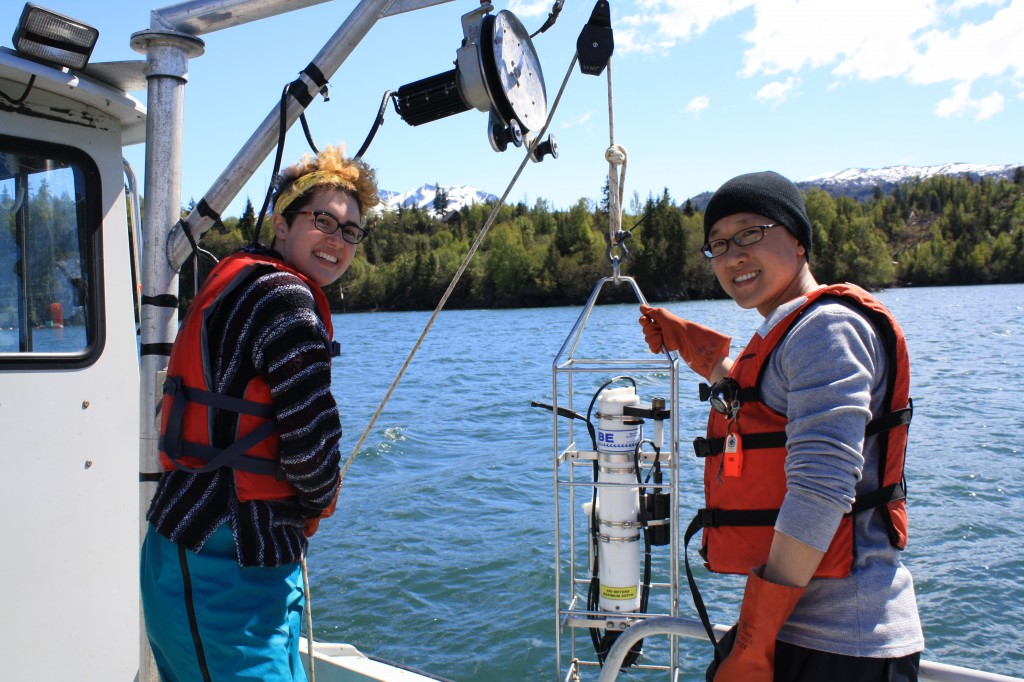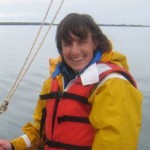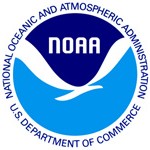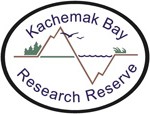Salt and fresh mix, in
diamond-tipped blue water
Photosynthesis
Why are we sampling?
The waters of Kachemak Bay and lower Cook Inlet are rich with plankton, kelp, and seagrass, which form the base of the food web for the fish, shellfish, marine mammals and seabirds living in this region. The primary production from plankton and marine plants is in turn driven by ocean conditions, which varies with temperature, salinity, oxygen, turbidity and nutrients. We are measuring oceanography and plankton in Cook Inlet to understand how changing environmental conditions affect species injured by the Exxon Valdez oil spill and coastal ecosystem food webs over the long term. We provide data and information products to support agency management for spill-injured species, to detect climate changes that may affect those species and lead to ecosystem regime shifts, and to characterize year-round marine conditions for Gulf Watch Alaska scientists who monitor nearshore intertidal, fish, marine mammal, and bird populations.
Where are we sampling?
We are sampling at stations on across- and along-bay lines in Kachemak Bay and in southeast Cook Inlet, and at nearshore sites in Seldovia Harbor, Kasitsna Bay, Homer Harbor, and a mooring in Bear Cove near the head of Kachemak Bay.
How are we sampling?
We conduct monthly boat surveys year-round to sample at repeated stations along transects in Kachemak Bay and lower Cook Inlet. During these surveys we collect oceanographic data from the surface to the bottom, conduct zooplankton and phytoplankton tows, and make opportunistic seabird and marine mammal observations. We have sensors installed to collect continuous water quality data year-round at two sites, Seldovia and Homer harbors, and in ice-free months at a mooring in Bear Cove. We also routinely collect phytoplankton samples at the Kasitsna Bay Laboratory dock.
What are we finding?
Continuous water quality station data from Kachemak Bay show that water temperatures were warmer and fresher in summer 2019 than in summer 2018, with temperatures exceeding 15°C at the Homer harbor station and 17°C in Bear Cove at the head of the bay. These are the highest daily average water temperatures we have ever observed at the Bear Cove mooring and even higher than what was seen during the marine heat wave in 2014-2016. Since October 2018, monthly average water temperatures in the bay have been warmer than the long-term average, with anomalies of up to 2 ˚C, and averaging near 1 ˚C above normal. These monthly temperature anomalies were very similar to the anomalies during the marine heatwave and follow more normal conditions in 2017 and most of 2018. Kachemak Bay waters were also lower in salinity than the long-term average in summer 2019, although there was not as much freshening as was seen during 2014-2016. It was initially surprising to find that water salinity remained similar to what was observed in previous years, rather than increasing due to lack of precipitation and moderate drought conditions experienced in the region from June to August 2019. The salinity observations indicate that the reductions in freshwater inputs from lack of rain were balanced by increased inputs of glacial meltwater associated with the persistent sunny weather and warm summer air temperatures. Bear Cove salinities were also the lowest observed during the GWA study period and that station is the one most directly influenced by glacial meltwater.

DAILY AVERAGED NEAR-SURFACE SEA TEMPERATURE (TOP) AND SALINITY (BOTTOM) FOR THREE WATER QUALITY STATIONS IN KACHEMAK BAY, ALASKA FOR THE JANUARY 2012 TO JULY 2019 PORTION OF AN 18-YEAR TIME SERIES. SELDOVIA HARBOR (BLUE) CONDITIONS IN THE OUTER BAY REFLECT MORE OPEN OCEAN CONDITIONS, WITH A SMALLER RANGE OF SEASONAL TEMPERATURES AND HIGHER SALINITIES. HOMER HARBOR (GREEN) AND BEAR COVE (ORANGE) OBSERVATIONS REFLECT THE GREATER INFLUENCE OF FRESHWATER INPUT IN THE INNER BAY, WITH A LARGER SEASONAL TEMPERATURE RANGE AND LOWER SALINITIES.

MONTHLY AVERAGE WATER TEMPERATURES (DASHED LINE) AND ANOMALIES (RED BARS-WARM, BLUE BARS-COOL) CALCULATED FROM CONTINUOUS DATA FROM THE NEAR-BOTTOM SENSOR AT THE SELDOVIA HARBOR KACHEMAK BAY NATIONAL ESTUARINE RESEARCH RESERVE WATER QUALITY MONITORING STATION FROM MAY 2001 TO JULY 2019 (AGAINST 2002-2018 MONTHLY MEANS).
While warm temperatures persisted from 2014 to 2015, the biological response was much more dramatic in 2015. Seabird and sea otter mortalities were extensive and, in September 2015, the first paralytic shellfish poisoning event and oyster farm closures in over a decade occurred in Kachemak Bay.
Leveraging other NOAA/National Centers for Coastal Ocean Science (NCCOS) and Kachemak Bay National Estuarine Research Reserve (KBNERR) efforts, we also monitor harmful algal species in the project area. We quantify the abundance of Alexandrium and Pseudo-nitzchia species from phytoplankton samples, and also test shellfish tissues for paralytic shellfish poisoning (PSP) toxins, from samples collected around Kachemak Bay. The toxic phytoplankton that causes PSP (Alexandrium spp.) was present in Cook Inlet and Kachemak Bay during each year of the project, with maximum cell concentrations increasing with warmer than average water conditions in 2014-2016 and decreasing with cooler conditions in 2017 through summer 2018. Increased amounts of Alexandrium spp. were observed in July and early August 2019 (again with warmer than average conditions), although abundances remained below 500 cells/liter and observed shellfish toxicity levels stayed below the limit recommended for human shellfish consumption. We continue to monitor for Pseudo-nitzschia phytoplankton species and domoic acid, because of links between Pseudo-nitzschia blooms and domoic acid poisoning events further south on the west coast. Despite persistent Pseudo-nitzschia blooms in May-July 2019, we did not observe elevated domoic acid levels in tested shellfish tissues, which is consistent with results from previous years.

ALEXANDRIUM CELL ABUNDANCE ESTIMATED FROM QUANTITATIVE POLYMERASE CHAIN REACTION (QPCR) ANALYSES FOR ALL PHYTOPLANKTON SAMPLES COLLECTED IN LOWER COOK INLET AND KACHEMAK BAY, 2012-2019. NOTE LOGARITHMIC SCALE FOR CELL ABUNDANCE ON THE Y-AXIS. PARALYTIC SHELLFISH POISONING TOXINS ARE LIKELY TO BE DETECTED IN SHELLFISH TISSUES FOR CELL ABUNDANCES ABOVE A LIMIT OF 500 CELLS/LITER (DASHED LINE ON FIGURE).

SHELLFISH TISSUE TOXICITY FOR SAXITOXIN (PARALYTIC SHELLFISH POISONING [PSP] TOXIN) FROM 2016-2019 FOR SAMPLES TAKEN AROUND KACHEMAK BAY. NOTE LOGARITHMIC SCALE FOR THE Y-AXIS. CAUTIONARY REGULATORY LIMIT FOR PSP TOXIN LEVELS FOR HUMAN SHELLFISH CONSUMPTION (80 ΜG TOXIN/100G TISSUE) IS SHOWN AS A RED DASHED LINE.







